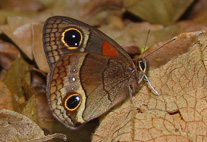Abstract
Some of the more valuable contributions of a standardized DNA sequence database (the DNA barcode) are matching spec-imens of different life stages and confirming the species identity of individuals from distant locations. These applications can facilitate the detective work required to solve difficult taxonomic problems. In this case, a match was made between the COI mtDNA sequence of an adult male wrasse recently caught at the tip of Baja California in Mexico in deep water (30–100m) and sequences from a series of unusual larvae collected about 3500 km to the south, in the open ocean over the Galápagos Rift hydrothermal vents in 1985. The Baja adults fit the recent description of Halichoeres raisneri Baldwin & McCosker, 2001 from the Galápagos and Cocos Islands. However, another deepwater labrid is known from the same site and depth in Baja; it is the type locality for the century-old holotype and only specimen of the Cape Wrasse Pseudo-julis inornatus Gilbert, 1890 (later as Pseudojuloides inornatus). Deepwater video images from the tip of Baja show wrasses identical to H. raisneri photographed in Galápagos but who also fit the description of Pseudojulis inornatus. This coincidence led to a closer investigation of the holotype with x-ray, which revealed unanticipated caniniform teeth (vs. incisiform in Pseudojuloides) and an error in the fin-ray count in the original description, both of which mistakenly sep-arated Halichoeres raisneri. The two species now match in markings, meristics, and morphology as well as overlapping range and are therefore synonymized. Phenetic and phylogenetic trees using mtDNA and nuclear DNA sequences show the species is not close to any other lineage and does not group with the other julidine labrids of the New World or the Pseudojuloides or Halichoeres of the Indo-Pacific. The distinctive larval morphology, long, thin, and flattened with a sharply pointed black-tipped snout, resembles no other described labrid larvae and, without an available genus, the new genus Sagittalarva Victor, n. gen. and the new combination Sagittalarva inornata (Gilbert, 1890), n. gen., n. comb. are described.

